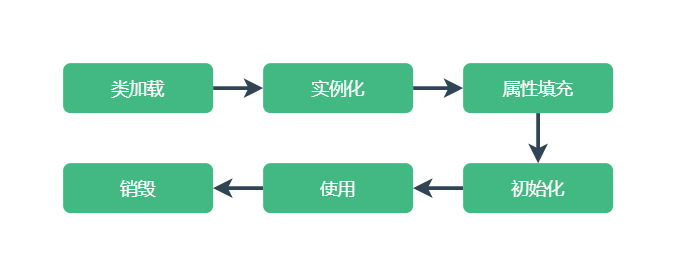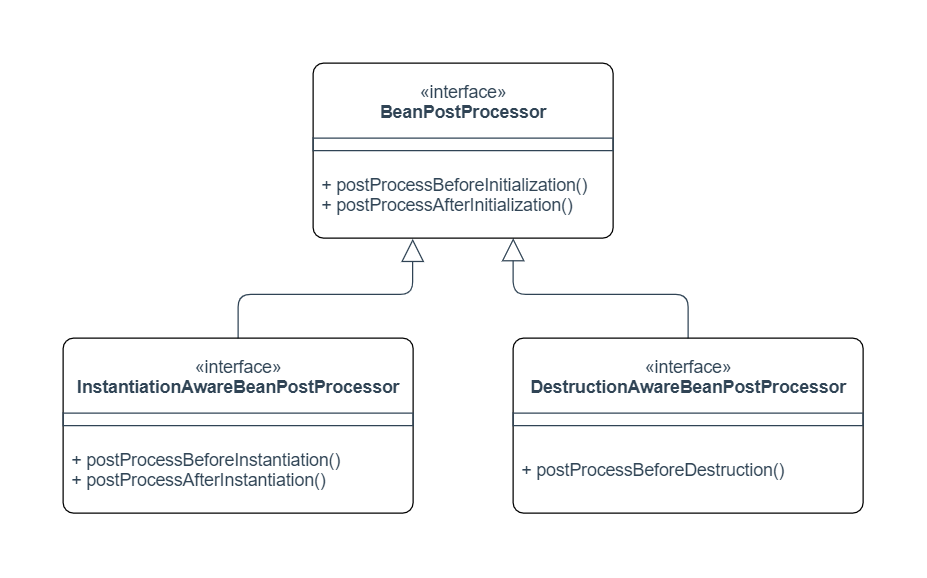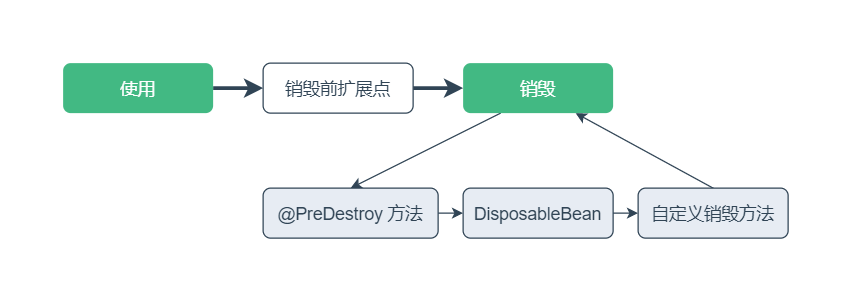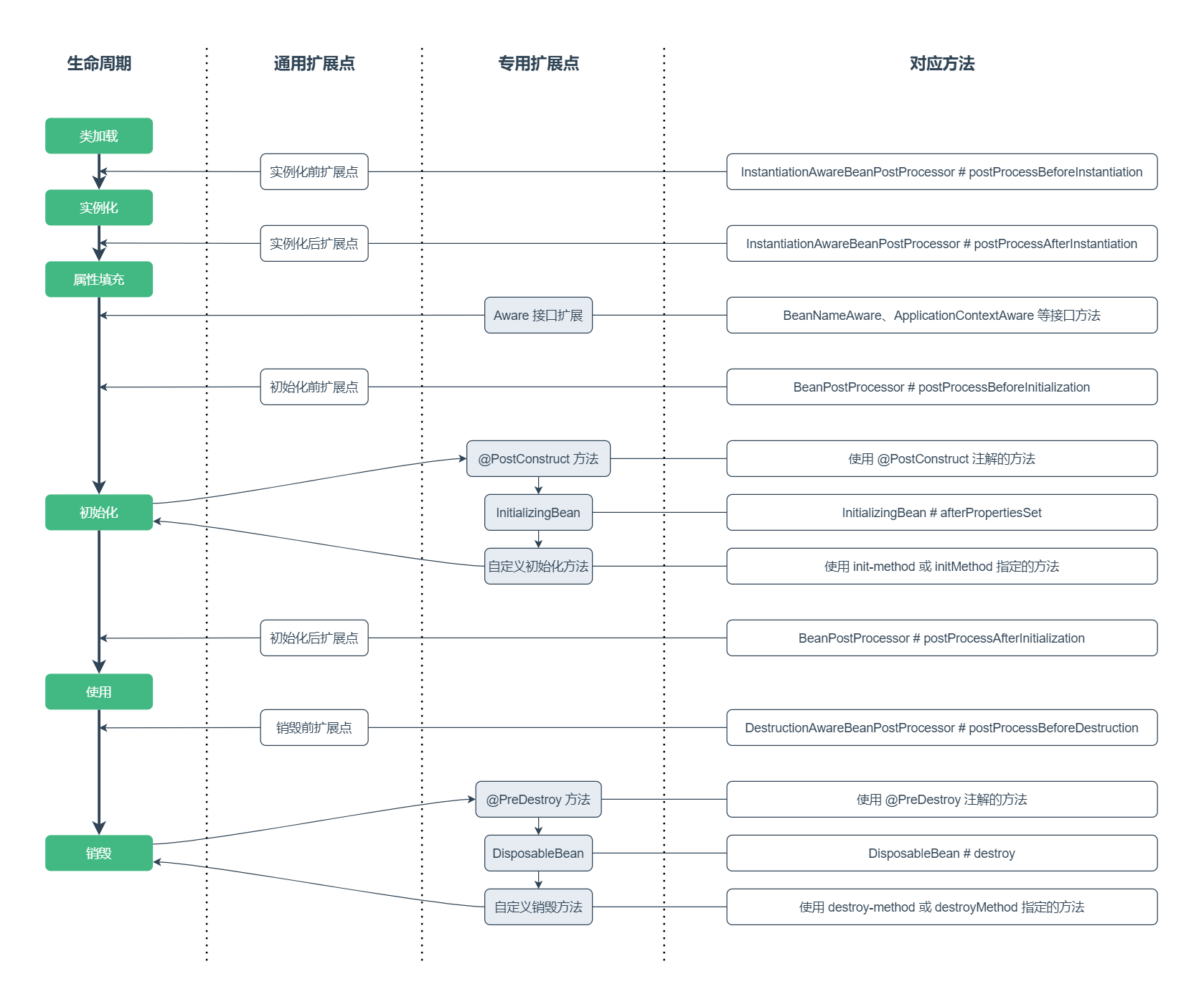The core of Spring is the IoC container. It is very important to understand the life cycle of beans, which is very helpful for the application and extension of Spring in the project.
1, Life cycle
The life cycle of a Bean mainly consists of four stages: instantiation, attribute filling, initialization and destruction, plus class loading and use. The whole process is as follows:

2, Bean extension
Spring provides extension points at each stage, which can be divided into two types:
- Special extension point: it is used for the extension of a single Bean. When defining the Bean class, implement the interface to extend the function.
- Common extension point: it is used for the extension of all beans, and the class implementation interface is defined separately to extend the function.
1. Dedicated extension point
Aware interface
Aware interface can inject Bean information or context information during attribute filling.
For example, you can inject the name of the current Bean into the class by implementing the BeanNameAware interface.
public class OneBeanExample implements BeanNameAware {
private String beanName;
@Override
public void setBeanName(String name) {
this.beanName = name;
}
}
Spring provides many Aware sub interfaces that can be used, including:
| Aware interface | Injection dependency |
|---|---|
| BeanNameAware | The name of the Bean |
| BeanFactoryAware | BeanFactory of the current context |
| ApplicationContextAware | ApplicationContext of the current context |
| ApplicationEventPublisherAware | Event publisher for the current context ApplicationEventPublisher |
| BeanClassLoaderAware | Class loader to load Bean classes |
InitializingBean and DisposableBean interfaces
If you want to add custom logic during Bean initialization, you can implement the InitializingBean interface.
If you want to add custom logic when the Bean is destroyed, you can implement the DisposableBean interface.
public class OneBeanExample implements InitializingBean, DisposableBean {
@Override
public void afterPropertiesSet() {
// do some initialization work
}
@Override
public void destroy() {
// do some destruction work
}
}
In addition to the above two callback interfaces, you can also specify custom initialization and destruction methods when registering beans.
@The initMethod attribute of the Bean annotation specifies the Bean initialization method, and the destroyMethod attribute specifies the Bean destruction method.
public class OneBeanExample {
public void init() {
// do some initialization work
}
public void destroy() {
// do some destruction work
}
}
@Configuration
public class AppConfig {
@Bean(initMethod = "init", destroyMethod = "destroy")
public OneBeanExample oneBeanExample() {
return new OneBeanExample();
}
}
The init method and destroy method attributes corresponding to the < bean > tag of the XML configuration.
You can also use the JDK's @ PostConstruct and @ PreDestroy annotations to specify initialization and destruction methods.
public class OneBeanExample {
@PostConstruct
public void init() {
// do some initialization work
}
@PreDestroy
public void destroy() {
// do some destruction work
}
}
The above three methods can define the methods to be executed during Bean initialization and destruction.
InitializingBean and DisposableBean interfaces are strongly coupled with Spring.
When the project does not rely on Spring, the second or third method is recommended.
2. General extension point
The general extension point is valid for all beans and needs to be implemented by defining separate classes. There are three main interfaces:
- BeanPostProcessor interface
- InstantiationAwareBeanPostProcessor interface
- DestructionAwareBeanPostProcessor interface

BeanPostProcessor interface
Implementing this interface can add custom logic before and after Bean initialization.
@Component
public class BeanInitProcessor implements BeanPostProcessor {
@Override
public Object postProcessBeforeInitialization(Object bean, String beanName) throws BeansException {
// before initialization work
return bean;
}
@Override
public Object postProcessAfterInitialization(Object bean, String beanName) throws BeansException {
// after initialization work
return bean;
}
}
InstantiationAwareBeanPostProcessor interface
Implementing this interface can add custom logic before and after Bean instantiation.
@Component
public class BeanInstanceProcessor implements InstantiationAwareBeanPostProcessor {
@Override
public Object postProcessBeforeInstantiation(Class<?> beanClass, String beanName) throws BeansException {
// before instantiation work
return null;
}
@Override
public boolean postProcessAfterInstantiation(Object bean, String beanName) throws BeansException {
// after instantiation work
return true;
}
}
DestructionAwareBeanPostProcessor interface
Implementing this interface can add custom logic before Bean destruction.
@Component
public class BeanDestroyProcessor implements DestructionAwareBeanPostProcessor {
@Override
public void postProcessBeforeDestruction(Object bean, String beanName) throws BeansException {
// before destruction work
}
}
3. Life cycle extension point example
The four stages of the Bean life cycle support extension, and custom logic can be added to each stage.
3.1 instantiation
The Spring container instantiates the Bean object in this step.
Implement two extension methods of the instantiaawarebeanpostprocessor interface, and add extensions before and after instantiation.

3.2 attribute filling
In this step, the Spring container fills in properties, such as injecting dependencies through the Setter method.
After the attribute is filled, the Bean information or context information is injected through the Aware interface extension.

3.2 initialization
The Spring container initializes the Bean at this step.
Implement the two extension methods of the BeanPostProcessor interface, and add extensions before and after initialization.

In the initialization phase, we mentioned three ways to specify the initialization method. Generally, one is OK.
If three methods are used at the same time, the methods specified in the three methods are the same, and the method is executed only once. When the methods specified in the three methods are different, they are executed in the order in the figure.
3.4 destruction
The Spring container destroys the Bean in this step to release external resources.
Implement the extension method of DestructionAwareBeanPostProcessor interface. You can add extensions before destruction.

In the destruction stage, we mentioned three ways to specify the destruction method. Generally, one is OK.
If three methods are used at the same time, the methods specified in the three methods are the same, and the method is executed only once. When the methods specified in the three methods are different, they are executed in the order in the figure.
4. Life cycle extension point sequence
In the life cycle of Bean, the execution sequence of general extension points, special extension points and their corresponding methods is as follows:

3, Appendix
1. Configuration properties
| attribute | describe |
|---|---|
| Init method attribute of < bean > | Specify a custom initialization method in the XML based configuration container |
| Destroy method attribute of < bean > | Specify a custom destruction method in the XML based configuration container |
2. Common notes
| annotation | describe |
|---|---|
| @initMethod property of Bean | In the Java based configuration container, specify the custom initialization method |
| @destroyMethod property of Bean | In the Java based configuration container, specify a custom destruction method |
| @PostConstruct | Use the JDK annotation to specify the method of initialization execution |
| @PreDestroy | Use the JDK annotation to specify the method of destruction execution |
3. Example code
Gitee warehouse: https://gitee.com/code_artist/spring
Project module: Spring IOC
Example path: cn.codertist.spring.bean.life
The latest article focuses on the CodeArtist code maker's official account.